The UV-B Monitoring and Research Program operates a national network of solar irradiance monitoring sites equipped with instruments that provide measurements to meet the needs of both agricultural and atmospheric researchers.
The electromagnetic spectrum covered by our suite of instruments is pictured below.
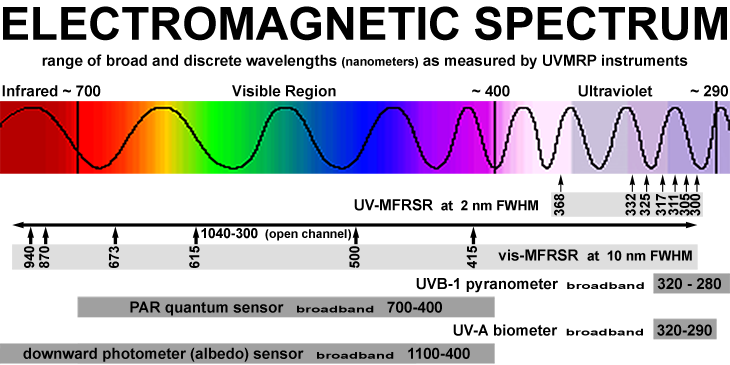
Our instrumentation includes:
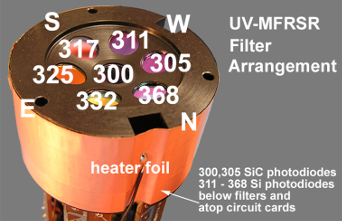
Yankee's Environmental Systems Ultraviolet Multifilter Rotating Shadowband Radiometer (UV-MFRSR) measures solar irradiance at seven narrowband wavelengths (nominal 300, 305, 311, 317, 325, 332, and 368 nm; each 2 nm FWHM) in the UV-B and UV-A regions. These wavelengths were selected to permit a Langley analysis (Slusser, et al., 2000) for the direct determination of optical depth. The 332 nm wavelength serves as a reference to Dobson instruments and the 311 is designed to be a reference point to a relatively unstructured (flat) portion of the UV spectra. The shadowband enables the instrument to measure the three components of solar irradiance, total horizontal, diffuse, and direct normal simultaneously across all seven channels through a single Lambertian diffuser made of Teflon®. The UV-MFRSR is environmentally sealed and thermally stabilized at ~42°C, and uses state-of-the-art interference filter photodiode detectors. The 300 and 305 channels use silicon-carbide (SiC) photodiodes, and the 311 through 368 channels use silicon (Ai) or gallium phosphate (GaP) photodiodes. Measurements are made every 20 seconds and integrated into 3-minute averages.
The data from this instrument is a voltage and has an averaged value for every 3 minutes for each of the 7 wavelengths for the three components, total horizontal, direct normal, and diffuse. Through our data processing procedures, the voltage is converted to an irradiance with units of watts per square meter per nanometer. Irradiance is a measurement of solar power and is defined as the rate at which solar energy falls onto a surface.
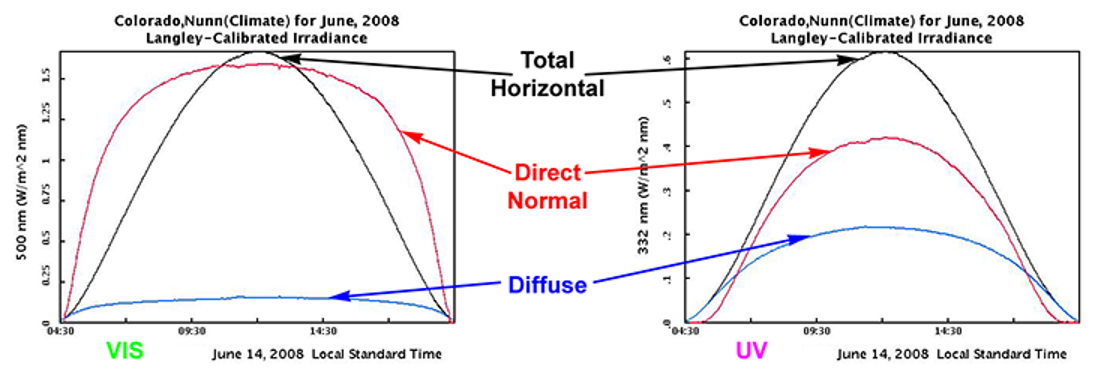
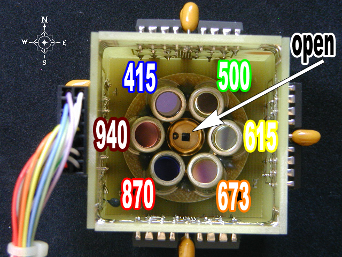
Yankee's Environmental Systems Visible Multifilter Rotating Shadowband Radiometer (vis-MFRSR) measures solar irradiance at six narrowband wavelengths (nominal 415, 500, 615, 673, 870, and 940 nm; each 10 nm FWHM) plus one unfiltered (open) silicon photodiode of 300-1040 nm. These wavelengths (except the 940 nm water-vapor band) were selected to permit a Langley analysis (Slusser, et al., 2000) for the direct determination of optical depth. The shadowband enables the instrument to measure the three components of solar irradiance, total horizontal, diffuse, and direct normal, simultaneously across all seven channels through a single Lambertian diffuser made of Spectralon®. The vis-MFRSR is environmentally sealed and thermally stabilized at ~40°C, and uses state-of-the-art interference filter photodiode detectors. All channels use silicon (Si) photodiodes, which for the six discrete wavelengths are each hermetically encapsulated with the appropriate filter. Measurements are made every 15 seconds and integrated into 3-minute averages.
The data from this instrument is a voltage and has an averaged value for every 3 minutes for each of the 7 wavelengths for the three components, total horizontal, direct normal, and diffuse. Through our data processing procedures, the voltage is converted to an irradiance with units of watts per square meter per nanometer. Irradiance is a measurement of solar power and is defined as the rate at which solar energy falls onto a surface.

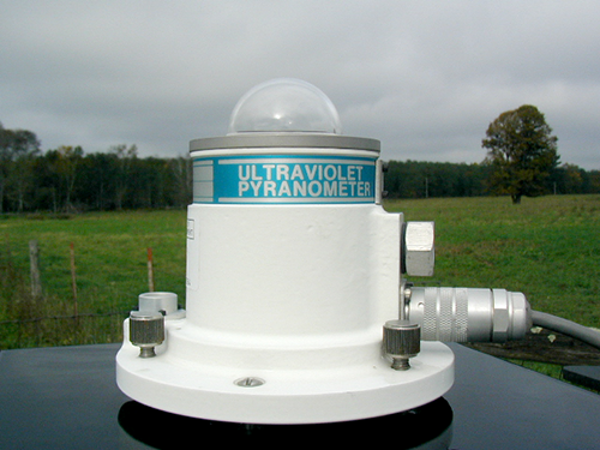 The UVB-1 Pyranometer, manufactured by Yankee's Environmental Systems, measures global irradiance in the UVB spectral range of 280-320 nm. The measurement technique employs a combination of colored glass optical filters to block the Sun's visible spectra and a UV-sensitive fluorescent phosphor to convert the UVB light o green light which is then measured with a solid-state GaAsP photodiode. The UVB-1 is environmentally sealed and thermally stabilized at ~45°C. Signal output is 0-4 volts DC, low impedance, corresponding to 0-7.88 Watts/meter2 of effective UVB irradiance. The UVB-1 instrument is measured every 15 seconds and integrated into 3-minute averages.
Through our data processing procedures, the three-minute averaged voltage from this instrument is converted into erythemal-weighted units, watts per square meter, which is that part of the UVB spectrum responsible for sunburn on human skin (erythema) and DNA damage.
The UVB-1 Pyranometer, manufactured by Yankee's Environmental Systems, measures global irradiance in the UVB spectral range of 280-320 nm. The measurement technique employs a combination of colored glass optical filters to block the Sun's visible spectra and a UV-sensitive fluorescent phosphor to convert the UVB light o green light which is then measured with a solid-state GaAsP photodiode. The UVB-1 is environmentally sealed and thermally stabilized at ~45°C. Signal output is 0-4 volts DC, low impedance, corresponding to 0-7.88 Watts/meter2 of effective UVB irradiance. The UVB-1 instrument is measured every 15 seconds and integrated into 3-minute averages.
Through our data processing procedures, the three-minute averaged voltage from this instrument is converted into erythemal-weighted units, watts per square meter, which is that part of the UVB spectrum responsible for sunburn on human skin (erythema) and DNA damage. 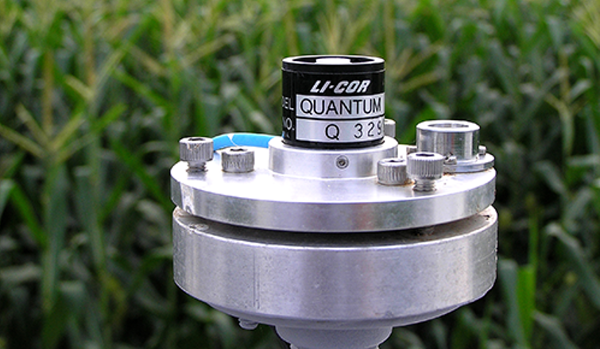
The LI-COR model LI-190SA Quantum Sensor measures photosynthetically active radiation (PAR) in the 400 nm to 700 nm wavelength range. The measurement is of Photosynthetic Photon Flux Density (PPFD), which has units of quanta (photons) per unit time per unit surface area, which for this sensor is in micromoles per second per square meter (µmol s-1m-2). LI-COR designed the quantum sensor to measure PAR incident on a flat plane. The sensor response approximates the photosynthetic response of plants. A silicon photodiode with enhanced response in the visible wavelengths is used as the detector. Under the acrylic diffuser are colored glass filters that tailor the silicon photodiode response to the desired quantum response, plus an interference filter that provides a sharp cutoff at 700 nm to eliminate interference from the infrared region. This instrument does not have any internal heating system, and thus operates at ambient temperature (operating range: -40°C to 65°C; 0 to 100% RH). Error calculations indicate that under sun-and-sky radiation, and various natural or artificial light sources, the relative errors are less than ±5%. Specifications and graphs are from the LI-COR instruction manual. The UVMRP uses the LI_190SA with the 2290 Millivolt Adapter. This adapter uses a 604 Ohm precision resistor to convert the LI-190 output from microamps to millivolts, to match the input parameters of the Yankee Environmental Systems datalogger. The PAR sensor output is measured every 20 seconds and integrated into 3-minute averages.
Plants use light in this wavelength range(400 - 700 nm) to drive photosynthesis. The efficiency with which plants use light varies somewhat across this range, but measuring PAR provides a consistent way to predict plant photosynthetic response regardless of the spectrum of the light source. Through our data processing procedures the three minute averaged voltage from this instrument is converted into µmol of photons m-2 s-1.
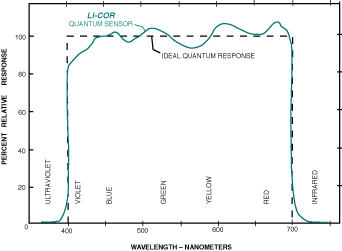
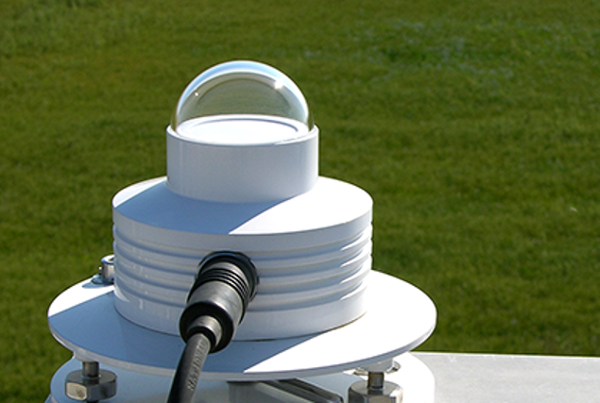
The UV-Biometer Model 501A (UVA), manufactured by Solar Light Company, measures global irradiance in the UV spectral range of 320-400 nm. The measurement technique employs a combination of colored glass optical filters to block the Sun's visible spectra and a UV-sensitive fluorescent phosphor to convert the UV light to green light which is then measured with a solid-state GaAsP photodiode. The UVA is environmentally sealed and thermally stabilized at ~25C. Its output is measured every 20 seconds and integrated into 3-minute averages.
Our UV-Biometer is available only at a few locations and due to no data processing procedures the output is provided as a three-minute averaged millivolt.
In addition to the above instruments, our sites are equipped with a Vaisala Air Temperature and Relative Humidity Sensor, Downward Looking Photometer, and some with a Vaisala Barometric Pressure Sensor. These instruments are used to provide an indication of the weather conditions around our site. UVMRP does not maintain calibration for these instruments. The data for these instruments is available by request.

